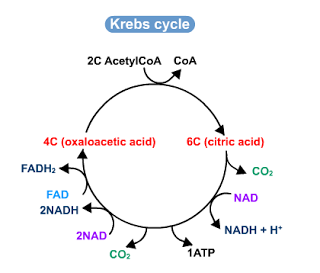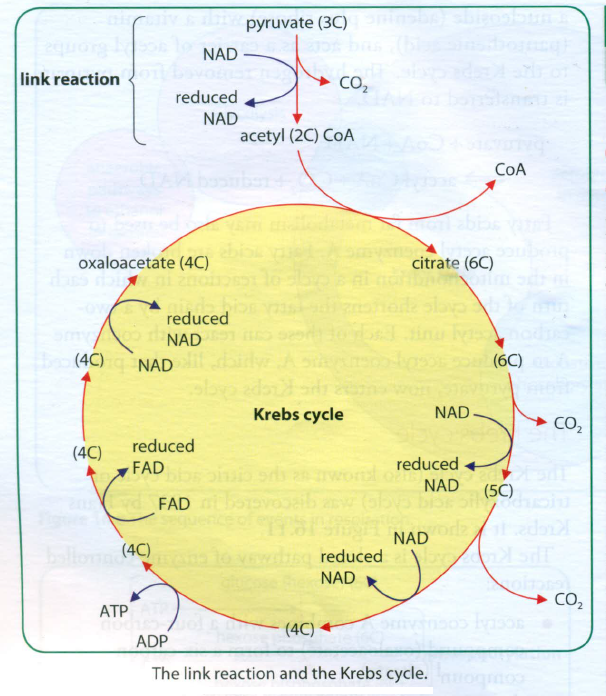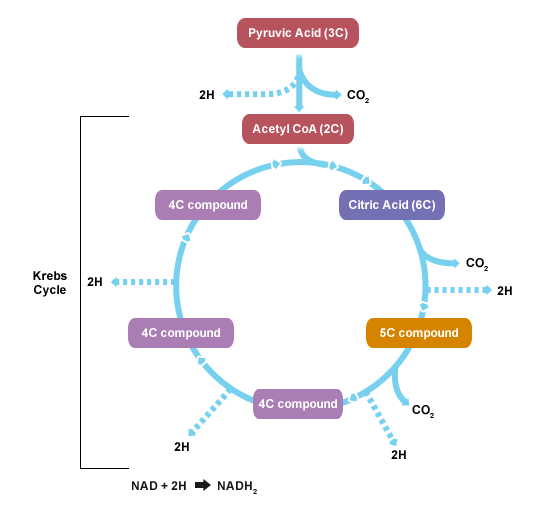Biology
 The Krebs cycle occurs in the matrix of the mitochondrion and is the aerobic phase and requires oxygen.
The Krebs cycle occurs in the matrix of the mitochondrion and is the aerobic phase and requires oxygen.
This is also known as the citric acid cycle or the tricarboxylic acid cycle.
- Krebs Cycle Broken Down
The Krebs cycle, also known as the Citric Acid cycle, is a very important process in cellular respiration. Without this portion, respiration would not be possible. This is because the Krebs cycle uses the pyruvate molecules from glycolysis to produce...
- #97 Summary Of Energy And Respiration
1 Organisms must do work to stay alive. The energy input necessary for this work is either light, for photosynthesis, or the chemical potential energy of organic molecules. Work includes anabolic reactions, active transport and movement. Some organisms,...
- #88 Aerobic Respiration, Link Reaction
If oxygen is available, each pyruvate now moves into a mitochondrion, where the link reaction and the Krebs cycle take place. During these processes, the glucose is completely oxidised. The link reaction In the link reaction, pyruvate enters the...
- #87 Respiration, Glycolysis
Respiration is the oxidation of energy-containing organic molecules. The energy released from this process is used to combine ADP with inorganic phosphate to make ATP. All cells obtain useable energy through respiration. Most cells use carbohydrate,...
- #85 Energy And Respiration - Syllabus 2016
12.1 Energy12.2 Respiration Energy is a fundamental concept in biology. All living things require a source of cellular energy to drive their various activities. ATP is the universal energy currency as its molecules are small,...
Biology
#89 The Krebs cycle

This is also known as the citric acid cycle or the tricarboxylic acid cycle.
The Krebs cycle is a series of steps catalysed by enzymes in the matrix:
? A 2-carbon atoms Acetyl CoA enters the cycle and combines with a 4-carbon compound (oxaloacetate) to give a 6-carbon compound (citrate/citric acid). Coenzyme A is reformed. Cycle turns twice for each original glucose molecule.
? The citrate is then gradually converted back to the 4-carbon oxaloacetate again in a series of small enzyme-controlled steps involving decarboxylation and dehydrogenation. 2 C atoms are released in 2 CO2 molecules and 4 pairs of H atoms are removed.
? The CO2 removed is given off as a waste product. It diffuses rut of the mitochondrion and out of the cell.
? The hydrogens removed are picked up by NAD and another coenzyme called FAD (flavin adenine dinucleotide). 1 FAD and 3 NAD molecules are reduced during each turn of the cycle. H in reduced NAD/FAD will be released in oxidative phosphorylation. The main role of the Krebs cycle in respiration is to generate a pool of reduced hydrogen carriers to pass on to the next stage.
? The regenerated oxaloacetate can combine with another ACoA.
? 1 ATP is produced directly by substrate-level phosphorylation for each ACoA entering the cycle.
? Amino acids and fatty acids can be broken down and fed into cycle.

 |
| Photo credit: BBC. |
? A 2-carbon atoms Acetyl CoA enters the cycle and combines with a 4-carbon compound (oxaloacetate) to give a 6-carbon compound (citrate/citric acid). Coenzyme A is reformed. Cycle turns twice for each original glucose molecule.
? The citrate is then gradually converted back to the 4-carbon oxaloacetate again in a series of small enzyme-controlled steps involving decarboxylation and dehydrogenation. 2 C atoms are released in 2 CO2 molecules and 4 pairs of H atoms are removed.
? The CO2 removed is given off as a waste product. It diffuses rut of the mitochondrion and out of the cell.
? The hydrogens removed are picked up by NAD and another coenzyme called FAD (flavin adenine dinucleotide). 1 FAD and 3 NAD molecules are reduced during each turn of the cycle. H in reduced NAD/FAD will be released in oxidative phosphorylation. The main role of the Krebs cycle in respiration is to generate a pool of reduced hydrogen carriers to pass on to the next stage.
? The regenerated oxaloacetate can combine with another ACoA.
? 1 ATP is produced directly by substrate-level phosphorylation for each ACoA entering the cycle.
? Amino acids and fatty acids can be broken down and fed into cycle.

Syllabus: 12.1 Energy c) explain that ATP is synthesised in Krebs cycle. 12.2 Respiration d) outline the Krebs cycle, explaining that oxaloacetate (a 4C compound) acts as an acceptor of the 2C fragment from acetyl coenzyme A to form citrate (a 6C compound), which is reconverted to oxaloacetate in a series of small steps e) explain that reactions in the Krebs cycle involve decarboxylation and dehydrogenation and the reduction of NAD and FAD |
- Krebs Cycle Broken Down
The Krebs cycle, also known as the Citric Acid cycle, is a very important process in cellular respiration. Without this portion, respiration would not be possible. This is because the Krebs cycle uses the pyruvate molecules from glycolysis to produce...
- #97 Summary Of Energy And Respiration
1 Organisms must do work to stay alive. The energy input necessary for this work is either light, for photosynthesis, or the chemical potential energy of organic molecules. Work includes anabolic reactions, active transport and movement. Some organisms,...
- #88 Aerobic Respiration, Link Reaction
If oxygen is available, each pyruvate now moves into a mitochondrion, where the link reaction and the Krebs cycle take place. During these processes, the glucose is completely oxidised. The link reaction In the link reaction, pyruvate enters the...
- #87 Respiration, Glycolysis
Respiration is the oxidation of energy-containing organic molecules. The energy released from this process is used to combine ADP with inorganic phosphate to make ATP. All cells obtain useable energy through respiration. Most cells use carbohydrate,...
- #85 Energy And Respiration - Syllabus 2016
12.1 Energy12.2 Respiration Energy is a fundamental concept in biology. All living things require a source of cellular energy to drive their various activities. ATP is the universal energy currency as its molecules are small,...
